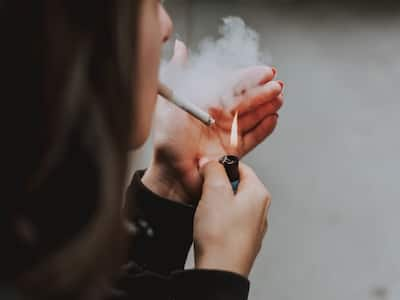
Estimates say nearly 14 per cent of individuals between the ages of 15 and 24 in India use tobacco in some form, including cigarettes and smokeless tobacco products.
Tobacco is responsible for more than 8 million deaths each year worldwide, including 1.2 million as the result of exposure to second-hand smoke. Tobacco is also one of the leading causes of most types of cancer. Every year, May 31 is dedicated as World No Tobacco Day (WNTD) to make people aware of the dangers of using tobacco. Being celebrated under the theme “We Need Food, Not Tobacco,” the 2023 global campaign aims to promote alternative crop production and marketing opportunities for tobacco farmers while encouraging them to grow sustainable, nutritious crops.
Speaking to TheHealthSite on World No Tobacco Day 2023, Dr Trivikrama Rao Mopidevi, Medical Oncologist, American Oncology Institute, Hisar, highlighted the alarming prevalence of tobacco use among the youth in India. He further sheds light on how tobacco is impacting the younger generation of India. He begins:
Tobacco use among the youth in India
Tobacco consumption has long been a significant concern for public health worldwide, and the younger generation of India is unfortunately not exempt from its detrimental effects. Despite increased awareness campaigns and stringent regulations, tobacco use continues to impact the youth in various ways, leading to both immediate and long-term consequences.
The prevalence of tobacco use among the youth in India is alarming. According to the Global Adult Tobacco Survey (GATS), nearly 14 per cent of individuals between the ages of 15 and 24 in India use tobacco in some form. This includes smoking cigarettes, chewing tobacco, and using smokeless tobacco products. The accessibility and affordability of tobacco products contribute to their widespread use among the younger population.
Impactsof tobacco use among the youth
One of the most significant impacts of tobacco consumption on the younger generation is the adverse health effects. Smoking and chewing tobacco increase the risk of numerous health conditions, including respiratory problems, cardiovascular diseases, and various types of cancer. These health issues not only affect individuals’ quality of life but also place a significant burden on the healthcare system.
Moreover, tobacco consumption negatively affects the educational attainment and overall development of young individuals. Smoking or using tobacco products often leads to addiction, which can interfere with academic performance and concentration. The financial burden of purchasing tobacco products also diverts resources that could be allocated for education and personal development.
Furthermore, tobacco use among the youth has social and economic implications. Young individuals who smoke or use tobacco may face social stigma, exclusion, and discrimination. This can affect their relationships, social interactions, and overall integration into society. Additionally, tobacco consumption often leads to increased healthcare costs for individuals and their families, putting an additional strain on already limited financial resources.
How tocombat the impact of tobacco consumption
Efforts to tackle tobacco consumption among the younger generation in India have included measures such as banning tobacco advertising near schools, implementing pictorial health warnings on tobacco products, and raising the legal age for purchasing tobacco. However, effective implementation and enforcement of these measures remain a challenge, and more comprehensive strategies are needed to address the issue.
To combat the impact of tobacco consumption on the younger generation, it is crucial to prioritize prevention and awareness programs. Comprehensive educational campaigns in schools, colleges, and communities can play a vital role in informing young individuals about the dangers of tobacco use and promoting healthier lifestyle choices. Additionally, offering support services, such as counseling and cessation programs, can help those already using tobacco to quit and prevent further addiction.
“The younger generation of India is being significantly impacted by tobacco consumption. The adverse health effects, educational hindrances, social stigma, and economic implications associated with tobacco use highlight the urgent need for comprehensive measures to address this issue. By focusing on prevention, awareness, and support, it is possible to protect the well-being and future of the younger generation and create a tobacco-free society,” Dr Rao sums up.
Some facts about tobacco use in India
More than 28 per cent of all adults consume tobacco (smoked or smokeless form), with men comprising over 42 per cent and women over 14 per cent.
READ RELATED: What Is Paediatric Hypertension: How Can It Impact Your Child?
The prevalence of tobacco use among adolescents is 19 per cent for males and 8 per cent for females.
The majority of tobacco users in India smoke beedi. Concerningly, beedi poses greater health risks to compared to cigarettes as it contains high amount of tar and other carcinogens.
Experts raise concern that inaccessibility to commercially available tobacco products may push younger individuals towards using the cheaper, locally made beedi. Not only it is a riskier alternative, but it would become practically impossible to control beedi in terms of trade, quality, and compliance with the law. Research indicates that beedis outsell cigarettes by a ratio of eight to one (8:1) in India.
Since 2003, the sale of tobacco products to individuals less than 18 years of age is prohibited in India. Offenders could be fined and imprisoned as penalties for related offences. Despite the ban, tobacco products are easily available in the neighborhoods, in both rural and urban India.
Tobacco consumption and tuberculosis (TB)
On World No tobacco Day, Dr. Pavan Asalapuram, Co-Founder, Empe Dianostics, wants to aware people about tuberculosis (TB), which has become a significant public health challenge. Tuberculosis (TB) is strongly linked to tobacco consumption.
Dr. Asalapuram expounds, “Tobacco consumption not only damages the lungs but also impairs the immune system, exacerbating the progression of the disease, leading to prolonged treatment periods, and increased mortality rates. Moreover, tobacco consumption contributes to the development of drug-resistant tuberculosis. Drug-resistant TB strains are more difficult to treat and require stronger, more expensive medications with potential side effects.”
“Additionally, tobacco smoke contains toxic substances that weaken the immune system and increase the likelihood of acquiring TB infection. It also impairs the body’s ability to clear TB bacteria from the lungs, delaying the healing process, and raising the risk of relapse. Furthermore, it worsens TB symptoms and outcomes, leading to a higher risk of complications and mortality. Unfortunately, not all patients recognise the harmful link between smoking and TB.”
He notes that enhancing TB diagnostics requires a comprehensive approach that involves government investment, optimal utilisation of digital health platforms, and collaboration with the healthcare provider industry. The first and most important step in treating TB is timely and correct diagnosis.
Our core responsibility is to make people aware of the risks associated with tobacco consumption and how it leads towards not just only TB but other life taking diseases such as cancer as well, he adds.
Total Wellness is now just a click away.
Follow us on
window.addEventListener(‘load’, (event) => {
// $(document).ready(function(){
$(‘#commentbtn’).on(“click”,function(){
(function(d, s, id) { var js, fjs = d.getElementsByTagName(s)[0]; if (d.getElementById(id)) return; js = d.createElement(s); js.id = id; js.src = “//connect.facebook.net/en_US/sdk.js#xfbml=1&version=v2.3”; fjs.parentNode.insertBefore(js, fjs);}(document, ‘script’, ‘facebook-jssdk’));
$(“.cmntbox”).toggle();
});
// });
});







